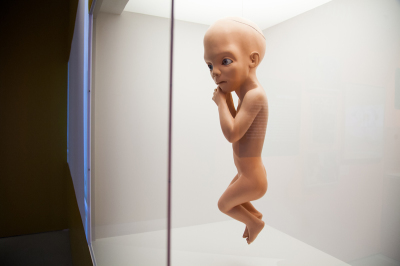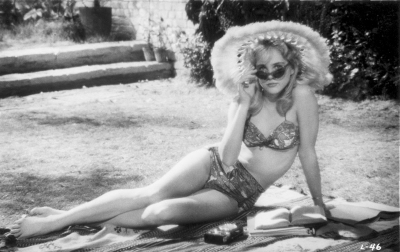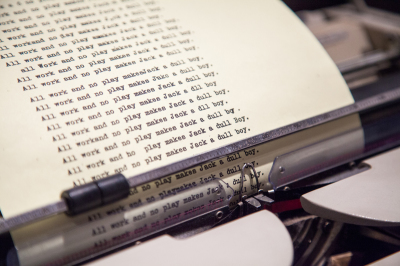Walking through the life of Kubrick at TIFF
STORY BY NICHOLAS OLSEN
From his self-taught roots in the trenches of anti-war filmmaking, to a space odyssey that would set a precedent for an entire genre — Stanley Kubrick is the subject of the most ambitious exhibition to hit the TIFF Bell Lightbox.
TIFF’s largest show to date, it features nearly 1,000 artifacts and 7,000 square feet of pure Kubrickian rooms, original costumes, photos, letters and more.
Accompanying the main show is Stanley Kubrick: A Cinematic Odyssey, a complete retrospective of Kubrick’s filmography: including screenings of his early self-financed works, 70mm presentations of 2001: A Space Odyssey (1968) and a rare international version of The Shining (1980).
Jesse Wente, Director of Film Programmes at TIFF, has a chronological vision to showcase how Kubrick evolved as an artist throughout his career.
“It’s been touring for ten years but we’ve really took it and redesigned it for our space. We chose to do this chronologically; in Los Angeles they’ve done it sort of thematically. You can see his growth and evolution as an artist better chronologically,” said Wente.
Each room is unique and visually intense, leading down the history of the celebrated director.
Beginning with Paths of Glory, Kubrick’s early anti-war film starring Kirk Douglas. Trench warfare in being waged on screen — with photographs of Kubrick and his actors on set — smiling, smoking and in deep concentration. Enclosed in glass are rough scripts and first editions of source material, in this case the novel by Humphrey Cobb.
Paths deals with cowardly soldiers in World War 1, and how their superior officers lay down consequences. Over 100 sandbags are stacked in the room to visualize the war era.
Later, a romantic Lolita section with hearts and cute pictures of Kubrick and 14-year-old star Sue Lyon on set dancing and partying. Guests can read an old letter sent to Kubrick by an older Sue Lyon later in her life, presumably after the two hadn’t spoken in years. Bellow the letter is a photograph of Lyon and her husband.
Lolita gained considerable controversy when first released in 1962 after receiving an X rating in the UK. The Catholic Church’s Legion of Decency “condemned” the film, making it a sin for Catholics to watch it.
Original artifacts from Dr. Strangelove or: How I Learned to Stop Worrying and Love the Bomb (1964) include a miniature war room appearing gigantic when focused inside its tomb.
An entire gallery annex transformed into a space room for 2001: A Space Odyssey. No sound can be heard and the original Starchild and Moonwatcher dwell here.
Standing 10-feet-tall is a recreation of the Monolith, seamless and painted a deep matte black. The villainous HAL 9000 appears — as well as spacesuits, storyboards and original drafts of the script. A large model of the spaceship used in the movie floats above.
2001 was one of the filmmaker’s most ambitious pictures, featuring over 205 SFX shots, pioneering a science fiction renaissance.
“We’ve designed one room per film and wanted to create an immersive experience for each film, so you really felt like you were there. My favorite is the 2001 space room, which you will notice has no sound,” said Laurel MacMillan, Director of Exhibitions at TIFF.
Beethoven’s determined portrait, the famous milkmaids — porcelain white statues of women who eject drug laced milk — and the original record player used by Alex DeLarge are shown off for A Clockwork Orange (1971), the ultra-violent adaptation of Anthony Burgess’ dystopian sci-fi novel. Kubrick was no stranger to controversy, and so Clockwork went on to receive the X rating in the United States and was “quietly removed” from circulation in the U.K. in 1974. It was not re-released in British cinemas until after Kubrick’s death in 1999.
Incredibly life-like costumes dominate the area dedicated to Barry Lyndon (1975), a 18th century period epic and a testament to the director’s attention to detail and absolute realism.
The Shining (1980) receives special attention from the organizers at TIFF with a recreation of The Overlook Hotel for guests to walk in. The spooky hotel room doors reading “ROOM 237” sit along the iconic carpet that has been recreated for the Toronto exhibit, covering over 575 square feet of floor. Washed — but still blood stained — the original blue dresses worn by the ghastly twins are a prominent piece. Also included are the prop weapons wielded by Jack Nicholson and Shelly Duvall, an axe and kitchen knife, respectively. On a table a miniature version of the famous hedge maze.
All of Stanley Kubrick’s big ten films have a unique place in the building, ending with Eyes Wide Shut (1999), his final and most dream-like picture about a man who finds himself in a self-destructive vortex of death and ritualistic sex after his wife confesses to being unfaithful. 14 beautiful Venetian masks from the movie can be seen, as well as the original costume worn by star Tom Cruise.
Running until Jan. 25. Wente encourages all to see this unique Torontonian testament to the legendary filmmaker.
“If you’ve ever seen a movie in your life, you should probably come see the Stanley Kubrick exhibition. If you’ve seen a science fiction movie made in the last 30 years, you’ve seen a movie that Stanley Kubrick influenced. You can come see where Star Wars, and very much where modern contemporary films like Interstellar get their roots. All of that is in the exhibition.”
Learn more here.
MORE RELATED TO THIS STORY:
- TIFF Cinematheque launches Godard retrospective
- Sheridan and TIFF bring Cronenberg’s evolution to life
- It’s an Emmy win for Sheridan alumni
Saved under Arts
Tags: 2001: A Space Odyssey, A Cinematic Odyssey, A Clockwork Orange, Barry Lyndon, Exhibition, Eyes Wide Shut, Jack Nicolson, Jesse Wente, Kirk Douglas, Kubrick, Laurel MacMillan, Lolita, Overlook Hotel, Paths of Glory, Shelly Duvall, Spartacus, Stanley Kubrick, Sue Lyon, The Shining, TIFF, TIFF Bell Lightbox, Tom Cruise, Toronto







